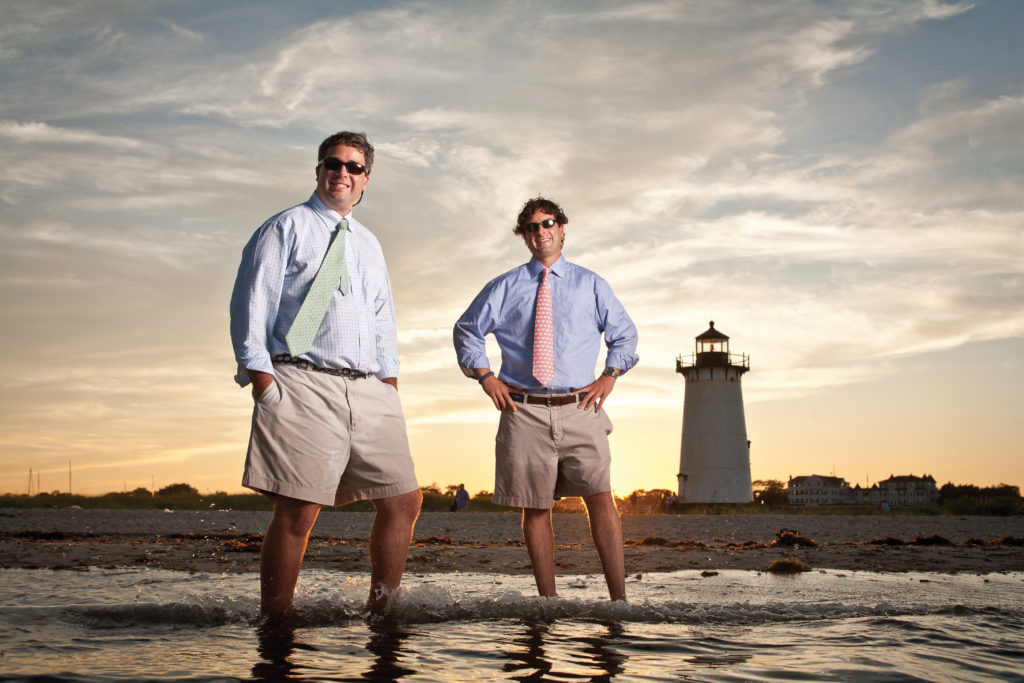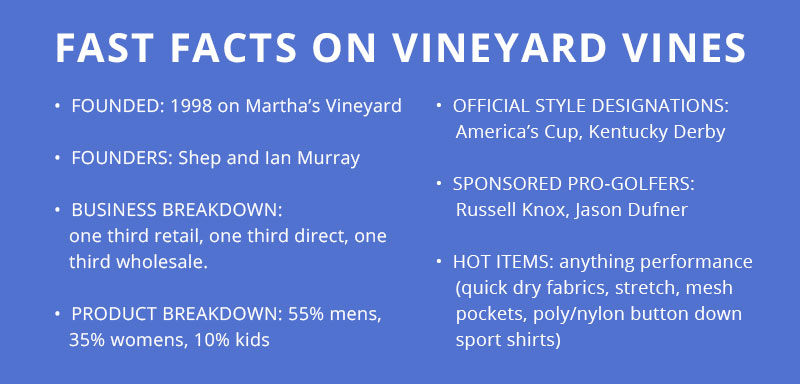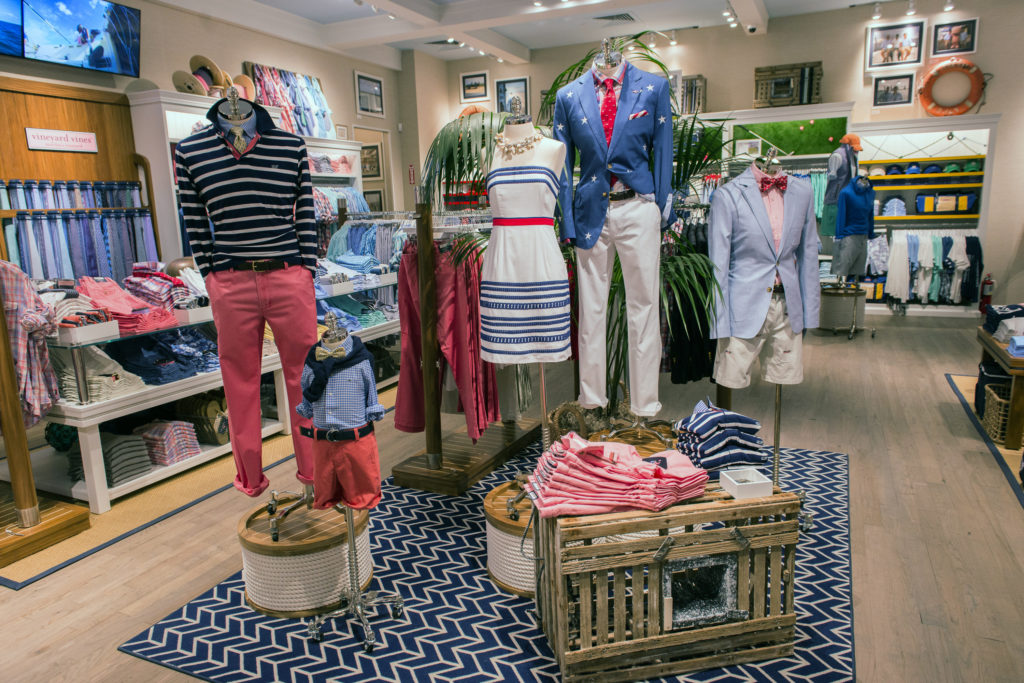BEST AMERICAN LIFESTYLE BRAND: VINEYARD VINES IS LIVING THE DREAM



 Remember the story of the poor fisherman who lived a contented life catching fish from his little wooden boat only to build a fishing empire so enormous that he had no time to do the one thing he actually loved?
Remember the story of the poor fisherman who lived a contented life catching fish from his little wooden boat only to build a fishing empire so enormous that he had no time to do the one thing he actually loved?
And so I ask Vineyard Vines founders Shep and Ian Murray: Has the business grown so big, so complex, so removed from its original concept that there’s little time to truly enjoy it?
“No way!” responds Shep, somewhat indignantly. “We’re still having fun. We love what we do. We make time for family and vacations. And we’ve assembled an amazing team to make it all possible.”
“Our brand is about people,” Ian explains. “And storytelling. When we started, it appeared we were selling neckties but what we were really selling was this story of two guys trying to create something different. And people were buying into this idea that work needn’t be painful. You can follow your dream, have a great time, surround yourself with people you like. We still do all that, just on a slightly larger scale. Our product is mostly a vehicle to take you someplace special in your mind.”
For those who don’t know the story, it’s a true fairytale: two 20-something brothers from Greenwich, Connecticut got fed up with their financial jobs and the requisite daily commute to Manhattan and decided there must be a better way. On the exact same day they quit their jobs and launched a little necktie collection, inspired by their childhood summers at Martha’s Vineyard. As Shep explains it, “In a sense, we started making ties so that we didn’t have to wear them. At first the idea was to dress people for life’s special occasions; this evolved into bringing those special feelings to everyday life.”
Clearly, they’ve done just that at their waterfront corporate headquarters in Stamford, CT. The fabulous 91,040-square-foot space is all open, friendly, and light, with amazing water views, alfresco eating areas, common spaces, lounges, a model store and a gym. About 250 employees make this their second home. “When we moved here in 2015,” notes Shep, “we envisioned three things: our own building, on the water, and reeking our brand. We researched and spoke to lots of people to determine what a successful office looks like. We had asked our people what they wanted and they said HVAC that works, decent bathrooms and parking spaces. Of course we gave them that and more: flextime options, tuition reimbursement, snacks in the lunchroom, and more. (We don’t let people eat lunch at their desks; we believe the mental break, camaraderie and exchange of ideas are all important.) And if you compare this office to our last one, it’s a lot different.”

From day one, Vineyard Vines has operated on an omni-channel model, fairly evenly balanced between their own retail, wholesale, and direct to consumer. And from day one, they’ve been growing in all three segments.
Major Vineyard Vines accounts include better department stores (Nordstrom, Bloomingdales) and some great specialty stores (Darien Sport, Perlis, Murray’s Toggery and many more). There are also 75 company-owned stores (a few are partnerships: Oak Hall, Puritan, Hudson News airport shops); there will be about 100 company stores by year’s end. Explains Ian, “We try to create spaces that are not about selling but rather venues where people can drop in, hang out, have a bite, listen to music, host events. In the process, they might decide to buy something but that’s not the point. We learned a lot from the Mitchells about hugging our customers; the notions of family and community are intrinsic to our brand.”
Interestingly, the Vineyard Vines catalog has become more of a marketing vehicle than a selling tool: it no longer includes order sheets but generates lots of calls.
“We’re all about authenticity,” Shep explains without hesitation. “Instead of models in our catalogs, we feature real people living real lives. Yes we’re storytellers, but nothing is fabricated.”
Among the “models” in their fabulous summer ’16 catalog: the Toppa family (competitive sailors), Ali (steel drum player), Matt and Jess Johnson (a married couple on a world beer sail), Paul Cayard (world sailing champion and Olympian), Johannes Erdmann (journalist at sea) and Tony Rey (a professional sailor who lives on his boat with his wife and kids).
As brand ambassadors, Vineyard Vines also uses professional golfers who wear their product on tour. This past April, they announced a two-year deal with PGA Tour Pro Russell Knox, winner of the 2015 WGC HSBC Champions. (They also sponsor PGA Tour Pro Jason Dufner.)
“We love Russell’s story,” says Ian, “because we relate to his perseverance and drive to achieve his goals. We share a sense of entrepreneurship: we both worked our tails off to be able to make a living doing what we love.”
Adds Shep, “We chose Russell and Jason because, although they’re hard-working professionals, they don’t take the game so seriously. They’re more like Hollywood frat golfers and they embody what Vineyard Vines is all about: going out there and having fun. If you don’t have your best day, you still can have a good day. And every day should feel that good! These partnerships, as well as our work with America’s Cup sailing, are bringing our brand visibility on the international stage, which is an incredibly exciting next step for us.”
 Another next step for the company: licensing, which they’ve thus far eschewed. “A common business mistake is to grow too quickly in too many directions,” says Shep. “We believe that to build a healthy business, you first need the right team and infrastructure in place. So sometimes the best decision to make is to not make one, to focus on making the things you do well even better before you add something new to the mix.”
Another next step for the company: licensing, which they’ve thus far eschewed. “A common business mistake is to grow too quickly in too many directions,” says Shep. “We believe that to build a healthy business, you first need the right team and infrastructure in place. So sometimes the best decision to make is to not make one, to focus on making the things you do well even better before you add something new to the mix.”
Adds Ian, “But we definitely view licensing as an opportunity. This might include home, shoes, eyewear, accessories, restaurants. We’re trying to analyze which would be best and in what order.”
Asked about mistakes and challenges, Shep talks about the need to continually evolve the brand, the product, and the team “so that we continue to make stuff that people want and provide an awesome experience. Maintaining our culture is important, but since we’re no longer the newest kid on the block, we must make sure that our message stays relevant.”
“Our culture is about learning from mistakes,” explains Ian. “The bad business climate in 2008 forced us to put disciplines in place and run our company tighter re: inventory, finances, and deliveries. You can’t be afraid to fail. You can make mistakes as long as you make more right decisions than wrong ones.”
Adds Shep, “Why worry about the past when you can’t change it? So we look back mostly to help us learn for the future.”
Ian continues: “The number one thing that we spend our time on is making sure vineyard vines is an incredible place to work. I just read this Richard Branson theory that makes sense to me: people first, customers second, shareholders third. This is perfectly aligned to our three Vineyard Vines goals: 1. Make this a great place to work. 2. Provide an awesome experience for our customers. 3. Drive profitable sales growth.”
Asked about recent reports that the company is looking to take in a partner to ultimately go public, Shep speaks candidly (but without actually answering the question). “We want to do what’s best for our brand. Being privately held has worked well for us these past 18 years, letting us focus on long-term growth rather than beating quarterly figures. But we’re always open to possibilities. We’re always looking at ways to make the company better.”
Asked about a recent article that valued the company at about a billion dollars, the boys responded in unison, “Wouldn’t that be nice?” But whether or not they go with a partner, both maintain that future growth will come from retail expansion, product extension, and continued customer acquisition.
Observes Ian, “There are still lots of people out there who don’t yet know about us.”








